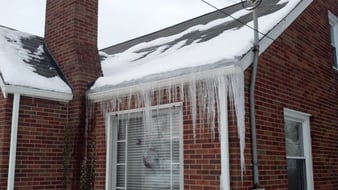 With the arrival of fall, and winter just around the corner, now is a good time to take measures to protect your home from the ravages of the bad weather to come. Wind, hail, heavy rain, snow, and ice are the most common causes of property damage to homes and businesses.
With the arrival of fall, and winter just around the corner, now is a good time to take measures to protect your home from the ravages of the bad weather to come. Wind, hail, heavy rain, snow, and ice are the most common causes of property damage to homes and businesses.
High-speed winds and hail can damage shingles and siding. Heavy rain can infiltrate structures from virtually any area that is not adequately weatherized. The weight of excessive snow can collapse roofs. Ice can build up in gutters and cause ice dams, resulting in leaks beneath the shingles.
Here are some tips for winterizing your home or business.
Start with the roof.
Most property claims come from roof damage. As you prepare for the fall season, follow this checklist to minimize the risk of damage to your roof:
- Inspect roof for damage and missing shingles, and make any necessary repairs.
- Clean leaves and debris from gutters and downspouts to allow for proper drainage and to prevent ice and snow from building up.
- Trim tree branches away from your structure and remove dead branches that may fall due to heavy wind, ice, or snow.
- Add more attic insulation to prevent ice dams. Ice dams are caused by excessive heat escaping from a poorly insulated attic, melting ice and snow on the roof and refreezing. This can cause water to build up and leak through the roof.
- Check to make sure flashing is in good condition to help prevent water penetration.
- Check for missing gravel on flat roofs, and repair any surface bubbles.
- If you plan to replace your roof, and you live in a hail-prone area, consider using impact-resistant roofing material.
Inspect the basement.
After the roof is secure, make sure your basement is in good condition.
- Have your furnace cleaned and inspected annually by a qualified technician.
- Keep flammable materials away from water heaters and wiring in the basement.
- Insulate water pipes along outside walls and in areas exposed to cold temperatures.
- Caulk or insulate around any pipes or conduit running through the basement walls to the outside.
- Turn up the thermostat during extra cold periods to prevent pipes from freezing.
Keep the weather outside.
Leaky doors and windows can allow rain, snow and cold air to get into your home or building. Over time, this can cause bigger problems, like wood rot, deterioration, and mold.
- Check for gaps around doors and windows, and caulk or repair as needed.
- Repair any loose or missing caulking around doors and windows.
- Check caulking around showers, bathtubs, sinks, toilets, and make repairs as needed.
- Check for air infiltration around electrical outlets on exterior walls. Insulate as needed.
Other problem areas to check and maintain.
Inspect wiring, appliances and any other areas that could cause problems:
- Have your chimney cleaned and maintained each year.
- Clean and/or replace the furnace filter.
- Clean the clothes dryer exhaust duct and space around and under the dryer. Remove all lint, dust, and any debris.
- Check your electrical outlets for potential fire hazards such as frayed wires or loose-fitting plugs.
- Be sure not to overload electrical outlets, fuse boxes, extension cords or any other power sources.
- Keep a multi-purpose fire extinguisher accessible, filled and ready for operation.

